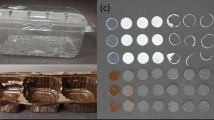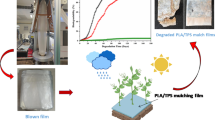Abstract
Compounds of plant origin are used in biodegradable polymers as stabilizers and functional additives. However, these substances often have a biological activity (antimicrobial) that can affect the biodegradability of these polymers. The objective of this work is to study the effect of two polyphenols, quercetin and gallic acid on the biodegradability of the natural polyester poly(3-hydroxybutyrate-co-3-hydroxyvalerate) (PHBV). The biodegradation of the materials was evaluated in pure liquid culture media in the presence of the PHBV-degrading bacterium Streptomyces exfoliatus, and also by a respirometric test in compost. The bacterial inhibition was demonstrated from the second and fourth month of incubation in the presence of quercetin and gallic acid, respectively. This was confirmed by optical microscopic observations of the bacterial cells (showing the disappearance of the bacterial filament network) and scanning electron microscopy analysis (showing no structural change on the surface of the additivated films). However, all the films produced were considered fully biodegradable, according to the specification standard NF T51-800, leading to the conclusion that the use of polyphenolic additives to PHBV materials (instead of synthetic additives) to improve their functionality is not an obstacle to their biodegradation in home compost.






Similar content being viewed by others
References
Kaza SAY, Lisa A, Bhada-Tata PA, Van Woerden F (2018) What a Waste 2.0: a Global Snapshot of Solid Waste Management to 2050
Plastics Europe (2021) Plastics-The facts 2021. https://plasticseurope.org/knowledge-hub/plastics-the-facts-2021/
Moshood TD et al (2022) Biodegradable plastic applications towards sustainability: a recent innovations in the green product. Clean Eng Technol. https://doi.org/10.1016/j.clet.2022.100404
Meereboer KW, Misra M, Mohanty AK (2020) Review of recent advances in the biodegradability of polyhydroxyalkanoate (PHA) bioplastics and their composites. Green Chem 22(17):5519–5558
Raza ZA, Abid S, Banat IM (2018) Polyhydroxyalkanoates: characteristics, production, recent developments and applications. Int Biodeterior Biodegrad 126:45–56
Jost V (2018) Packaging related properties of commercially available biopolymers—an overview of the status quo. Express Polym Lett 12:429–435
Ragaert P et al (2019) Polyhydroxyalkanoates for food packaging applications. In: Smithers GW (ed) Reference module in food science. Elsevier, Amsterdam
Havstad MR (2020) Biodegradable plastics. In: Letcher TM (ed) Plastic waste and recycling. Elsevier, Amsterdam, pp 97–129
Weng YX et al (2010) Biodegradation behavior of PHBV films in a pilot-scale composting condition. Polym Test 29(5):579–587
Volova TG et al (2017) Microbial degradation of polyhydroxyalkanoates with different Chemical Compositions and their biodegradability. Microb Ecol 73(2):353–367
Zaheer MR, Kuddus M (2018) PHB (poly-β‐hydroxybutyrate) and its enzymatic degradation. Polym Adv Technol 29(1):30–40
Bioplastics market development update 2021. https://docs.european-bioplastics.org/publications/market_data/2021/Report_Bioplastics_Market_Data_2021_short_version.pdf
Zheng Y et al (2020) Engineering biosynthesis of polyhydroxyalkanoates (PHA) for diversity and cost reduction. Metab Eng 58:82–93
Bonnenfant C, Gontard N, Aouf C (2022) Extending biopolyesters circularity by using natural stabilizers: a review on the potential of polyphenols to enhance poly (hydroxyalkanoates) thermal stability while preserving its biodegradability. Polym Test 110:107561
Górniak I, Bartoszewski R, Króliczewski J (2019) Comprehensive review of antimicrobial activities of plant flavonoids. Phytochem Rev 18(1):241–272
Lima MdC et al (2019) A review of the current evidence of fruit phenolic compounds as potential antimicrobials against pathogenic bacteria. Microb Pathog 130:259–270
Bonnenfant C, Gontard N, Aouf C (2022) Biobased and biodegradable polymers in a circular economy context: understanding quercetin and gallic acid impacts on PHBV thermal properties. Polym Degrad Stab 201:109975
Shah AA et al (2014) Microbial degradation of aliphatic and aliphatic-aromatic co-polyesters. Appl Microbiol Biotechnol 98(8):3437–3447
Vandi L-J et al (2019) Experimental data for extrusion processing and tensile properties of poly(hydroxybutyrate-co-hydroxyvalerate) (PHBV) polymer and wood fibre reinforced PHBV biocomposites. Data Brief 22:687–692
Chatellard L, Trably E, Carrère H (2016) The type of carbohydrates specifically selects microbial community structures and fermentation patterns. Bioresour Technol 221:541–549
Srithep Y et al (2013) Melt compounding of poly (3-hydroxybutyrate-co-3-hydroxyvalerate) (PHBV)/nanofibrillated cellulose (NFC) nanocomposites: properties and solubility of carbon dioxide. In: Annual Technical Conference—ANTEC, Conference Proceedings, vol. 1, pp 866–871
David G et al (2020) How vine shoots as fillers impact the biodegradation of PHBV-based composites. Int J Mol Sci 21(1):228
Jones SE, Elliot MA (2018) ‘Exploring’ the regulation of Streptomyces growth and development. Curr Opin Microbiol 42:25–30
Borges A et al (2013) Antibacterial activity and mode of action of ferulic and gallic acids against pathogenic bacteria. Microb Drug Resist 19(4):256–265
Nguyen TLA, Bhattacharya D (2022) Antimicrobial activity of quercetin: an approach to its mechanistic principle. Molecules 27(8):2494
Askun T et al (2009) Characterization of the phenolic composition and antimicrobial activities of turkish medicinal plants. Pharm Biol 47(7):563–571
Kuzyakov Y, Friedel J, Stahr K (2000) Review of mechanisms and quantification of priming effects. Soil Biol Biochem 32(11–12):1485–1498
Balaguer MP et al (2016) Compostability assessment of nano-reinforced poly (lactic acid) films. Waste Manage 48:143–155
Lammi S et al (2019) How olive pomace can be valorized as fillers to tune the biodegradation of PHBV based composites. Polym Degrad Stab 166:325–333
Lajarrige As (2019) Exploration des risques et des bénéfices liés à l’utilisation de nano-argiles dans des matériaux biodégradables destinés au contact alimentaire. Montpellier
Goel V et al (2021) Biodegradable/Bio-plastics: myths and realities. J Polym Environ 29:1–26
Acknowledgements
The authors are grateful to Cécile Barron for sharing her expertise in XLSTAT software and statistical analyses.
Funding
This project was supported by ministerial grant provided by the University of Montpellier.
Author information
Authors and Affiliations
Contributions
All authors contributed to the study conception and design. Material preparation, data collection and analysis were performed by CB and LC. The first draft of the manuscript was written by CB and all authors commented on previous versions of the manuscript. All authors read and approved the final manuscript.
Corresponding author
Ethics declarations
Conflict of interest
The authors have no relevant financial interests to disclose.
Additional information
Publisher’s Note
Springer Nature remains neutral with regard to jurisdictional claims in published maps and institutional affiliations.
Rights and permissions
Springer Nature or its licensor (e.g. a society or other partner) holds exclusive rights to this article under a publishing agreement with the author(s) or other rightsholder(s); author self-archiving of the accepted manuscript version of this article is solely governed by the terms of such publishing agreement and applicable law.
About this article
Cite this article
Bonnenfant, C., Chatellard, L., Gontard, N. et al. Effect of Quercetin and Gallic Acid on the Microbial Degradation of Poly(3-hydroxybutyrate-co-3-hydroxyvalerate) (PHBV) Materials. J Polym Environ 31, 1478–1488 (2023). https://doi.org/10.1007/s10924-022-02708-7
Accepted:
Published:
Issue Date:
DOI: https://doi.org/10.1007/s10924-022-02708-7




